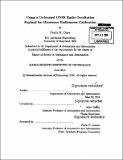| dc.contributor.advisor | Kerri Cahoy. | en_US |
| dc.contributor.author | Davé, Pratik K. (Pratik Kamlesh) | en_US |
| dc.contributor.other | Massachusetts Institute of Technology. Department of Aeronautics and Astronautics. | en_US |
| dc.date.accessioned | 2015-02-05T18:22:17Z | |
| dc.date.available | 2015-02-05T18:22:17Z | |
| dc.date.copyright | 2014 | en_US |
| dc.date.issued | 2014 | en_US |
| dc.identifier.uri | http://hdl.handle.net/1721.1/93798 | |
| dc.description | Thesis: S.M., Massachusetts Institute of Technology, Department of Aeronautics and Astronautics, 2014. | en_US |
| dc.description | Cataloged from PDF version of thesis. | en_US |
| dc.description | Includes bibliographical references (pages 55-58). | en_US |
| dc.description.abstract | This study presents a new method of calibrating an orbital cross-track scanning microwave radiometer using a co-located radio occultation (RO) instrument with Global Navigation Satellite Systems (GNSS). The radiometer and RO receiver periodically observe the same volume of atmosphere near the earth's limb, allowing for overlapping, or collocated, measurements that can be used to calibrate the radiometer. This method leverages the benefits of both remote sensing techniques to strengthen the science returned with the goal of achieving dense geospatial sampling and highly accurate calibration. Performance analyses show that the technique is particularly well-suited for implementation on a low-cost CubeSat hosting both radiometer and RO receiver systems on the same spacecraft. We describe a validation platform for this calibration method, the Microwave Radiometer Technology Acceleration (MiRaTA) CubeSat, currently in development by MIT Lincoln Laboratory and MIT Space Systems Laboratory for the NASA Earth Science Technology Office. MiRaTA will fly a multi-band radiometer and the Compact TEC/Atmosphere GPS Sensor (CTAGS) in 2016. We investigate the effect of system design parameters such as hardware specifications and operational concepts on the performance of this co-located remote sensing method. | en_US |
| dc.description.statementofresponsibility | by Pratik K. Dave. | en_US |
| dc.format.extent | 58 pages | en_US |
| dc.language.iso | eng | en_US |
| dc.publisher | Massachusetts Institute of Technology | en_US |
| dc.rights | M.I.T. theses are protected by copyright. They may be viewed from this source for any purpose, but reproduction or distribution in any format is prohibited without written permission. See provided URL for inquiries about permission. | en_US |
| dc.rights.uri | http://dspace.mit.edu/handle/1721.1/7582 | en_US |
| dc.subject | Aeronautics and Astronautics. | en_US |
| dc.title | Using a co-located GNSS radio occultation payload for microwave radiometer calibration | en_US |
| dc.type | Thesis | en_US |
| dc.description.degree | S.M. | en_US |
| dc.contributor.department | Massachusetts Institute of Technology. Department of Aeronautics and Astronautics | |
| dc.identifier.oclc | 900609740 | en_US |
